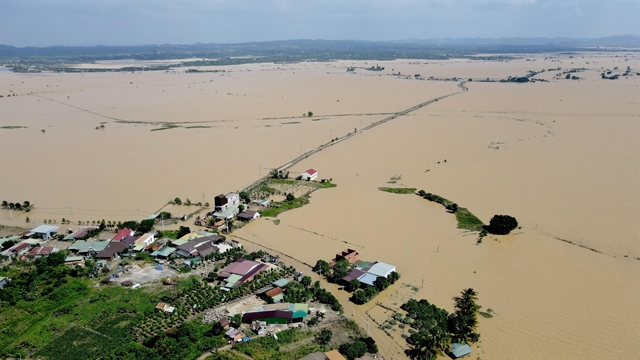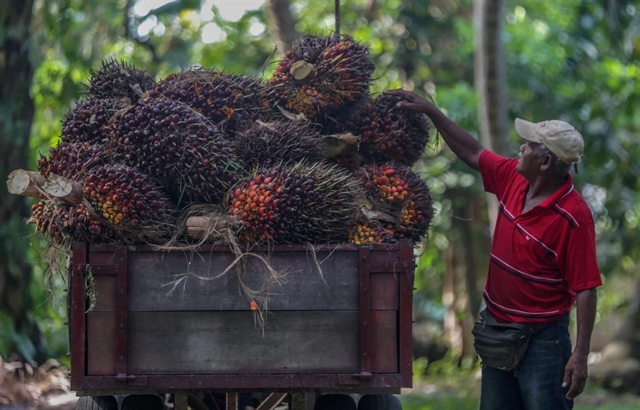 Society
Society

Using social media to help spread information is part of a Citi Foundation’s project for COVID-19-related community relief and economic recovery efforts globally.

|
| Nguyễn Đăng Minh (first right) head of Tốt Động Commune health station in Hà Nội’s Chương Mỹ District, speaks at an information dissemination meeting held in the locality on November 22. VNS Photo Mai Hiên |
by Mai Hiên
HÀ NỘI — It was 3pm on Sunday afternoon when a group of youth union members in green uniforms in Hà Nội’s Chương Mỹ District and women's union members gathered for a meeting where they could listen to the latest information on disease prevention and public healthcare.
“It’s helpful for us,” said 23-year-old Lê Thị Bảo Ngọc.
"Although the information about diseases is available on mass media, not many people clearly understand the symptoms as well as prevention measures," she said.
“Knowing about the symptoms, the causes and how to prevent common non-communicable diseases helps enhance our awareness, especially for hypertension.”
By listening to the information, which was carefully edited by Nguyễn Đăng Minh, head of Tốt Động Commune health station, youth union members like Ngọc learnt about factors that can increase the risk of high blood pressure including health conditions, lifestyles and family history.
“Some of the risk factors for high blood pressure cannot be controlled, such as our age or family history. But we can take steps to lower our risks by changing the factors we can control. These include unhealthy diet, obesity, physical inactivity, and use of tobacco or alcohol,” Minh said.
Đặng Thị Phương Hằng, Secretary of Tốt Động Commune Youth Union, agreed.
“After attending a similar meeting held last month, I got a lot of information on diseases such as hypertension and diabetes which are common nowadays."
"People suffering from hypertension are at high risk of strokes and heart diseases," she said.
Hằng said she had shared that information with her family members.
She also posted facts about the disease and preventive measures as well as posters relating to the disease on the commune’s social network to raise people’s awareness about public healthcare.
“Using social media helps spread information quickly and it’s easy for people to access,” Hằng said, adding that each family has two or three members using social media.
The initiative is part of the Citi Foundation’s project for COVID-19-related community relief and economic recovery efforts globally.
The project is carried out by Microfinance & Development Center (M&D) in 10 outlying districts of Hà Nội, namely Mỹ Đức, Ứng Hòa, Phú Xuyên, Thường Tín, Sóc Sơn, Mê Linh, Ba Vì, Thạch Thất, Chương Mỹ and Thanh Oai.
The project concentrated on offering useful and timely information to the trainees. They were trained on information principles and how to produce news articles in different formats or how to communicate with people in information dissemination meetings.
According to Nguyễn Bích Vượng, director of the M&D, the commune’s President of the Women's Union and the Secretary of the Youth Union were chosen for training as they represent two mass organisations which are prestigious and experienced in mobilising members to join social movements with great influence.
“With the communication knowledge and skills from this training activity, these leaders will become the communicators and trainers of the local Women's Union and Youth Union.
Thus, there will be a large number of people involving in communication, helping them perform better in the prevention work and healthcare,” she said, adding that nearly 4,000 people have been trained since July this year.
Minh, head of Tốt Động Commune health station, said members of Tốt Động Commune Steering Committee for COVID-19 prevention and control were finding themselves busier than ever during the peak of the pandemic in March and July this year.
To enhance the joint efforts against the pandemic, the Committee has disseminated relevant information in all channels, including the commune’s radio, printed bulletins, or handouts to each household.
Health workers gathered information from the portals of the Ministry of Health, announcements of the government, local authority, or the press. They made reports and broadcasted them through communal loudspeaker network.
This is the station’s usual task but the difference is that this is now done daily instead of weekly or quarterly.
When asked about difficulties when it came to COVID-19 communication, Minh said arranging information dissemination meetings was a problem.
It was not easy to gather a large number of locals during the day because people are busy. Thus, meetings would usually be held at weekends, he said.
The commune has a population of 16,000 people. Most of them engaged in agriculture.
To provide information to every household, the Youth Union members use a mobile channel.
They drive motorbikes loaded with loudspeakers, travelling to every corner of the commune to broadcast the reports they have prepared.
“The communication on the COVID-19 pandemic is of utmost importance. Our activities have raised the effectiveness of the overall communication: 100 per cent of people in our commune are aware of the pandemic, know how dangerous it is, and know what to do to prevent it,” Minh said.
Dissemination on disease prevention is also included in communal and village meetings, making the task more effective.
“Most people wear masks in public. They wash their hands regularly and complete health declarations after returning from high-risk areas, he said.
The feedback was also recognised by Ngọc, who works at the local kindergarten.
Parents advised their children to wear masks and use hand sanitisers before entering the classroom, she said.
“Particularly, parents follow the regulations of wearing masks and keeping a safe distance between people at the school enrollment held in late August.” — VNS




